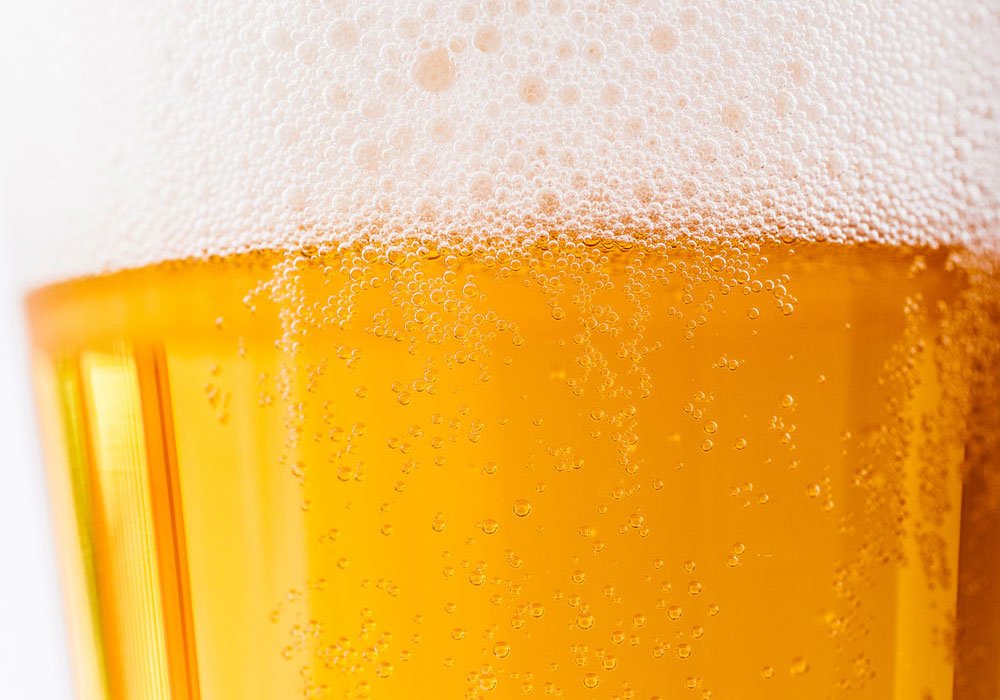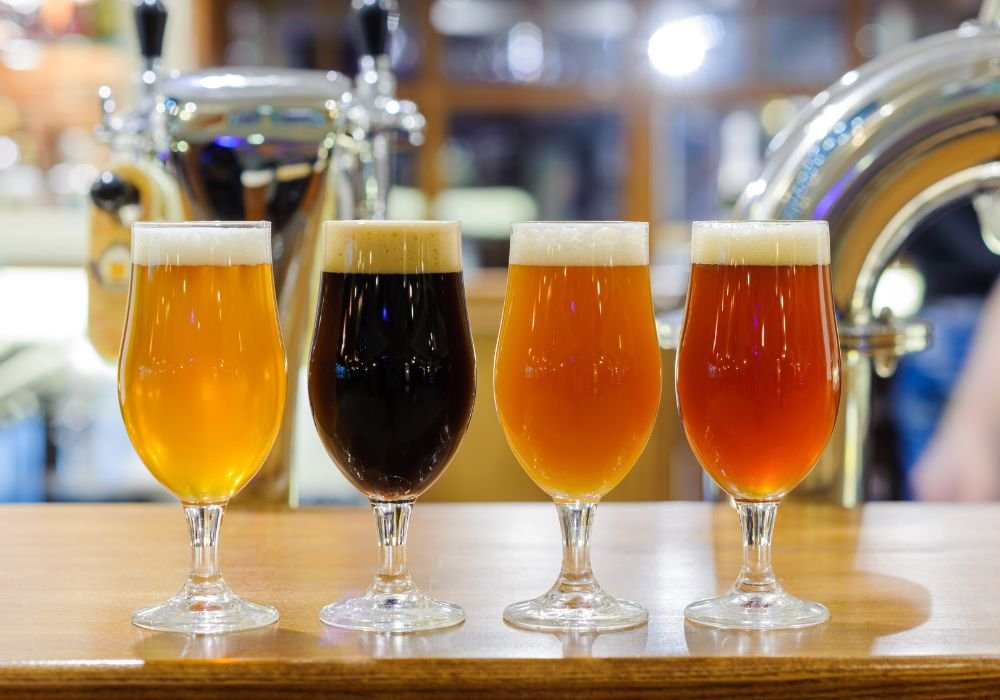Typical Characteristics of foam in Beer Quality

George Mathews
General Manager – Technical Brewing
The foam retention challenge is like a battle between good & evil. All beers contain more than enough CO2 to generate enough of bubbles, are capable of producing copious amounts of foam. It simply needs more ‘work’, to do the job!
Beer head, or foam or collar, is the result of the creation of gas bubbles, known as nucleation. The carbon dioxide that forms the bubbles in the head is produced during fermentation. The carbonation can occur before or after bottling the beer. If the beer continues fermenting in the bottle, then it naturally carbonates, and the head is formed upon opening and/or pouring the beer. If the beer is pasteurized or filtered, then the beer must be force carbonated using pressurized gas. Consumers tend to place a lot of importance on beer heads: too much of a head is undesirable because it detracts from the mass of the drink (similar to carbonated soda drinks), on the other hand a poured beer is viewed as incomplete unless it has the specific form of head expected for the type of beer.
Foam qualities of beer has a proportionate impact on the perceived value of the product. Brewers are generally worried about the appearance of a stable foam on their beer. Through this article, I’ve tried to identify the characteristics of a beer foam.
Characteristics of Good Foam:
- Nucleation: The creation of bubbles due to the CO2 present in beer, results in foam, or beer head, this is known as nucleation and is an important characteristic to making a good beer. To produce a good head, there needs to be good nucleation of bubbles, either by physical action (eg. Pumping), or through the influence of ‘nucleation sites’ such as particles in the glass.
- Retention: The foam should have stable retention. Retention, or the ability of beer to retain a nice foamy head for a duration of time, is an important characteristic of good beer. This is the point of difference between the froth on beer as opposed to that of soda or champagne. The ‘fizz’ in beer is due to presence of surface active substances which stabilize the head. Retention is a constant battle between foam stabilising molecules and foam inhibitors.
- Lacing: Another important aspect of a good foam is lacing. A pattern of foam that clings to the glass is known as lacing. Two major factors that determine the laciness of your beer is a) the type of beer and b) the cleanliness of the glass.
- Another important aspect is the impact of the precise nature of the laced foam. It may not be the lacing, rather its appearance. The beer employed in the study, which had been bittered with reduced iso-oxy acids, which leads to a foam substantially different from the one containing unmodified bittering components.
The foam retention challenge is like a battle between good & evil. All beers contain more than enough CO2 to generate enough of bubbles, are capable of producing copious amounts of foam. It simply needs more ‘work’, to do the job! The principle backbone material of foam is protein. These proteins originate from the malt, they actually increase during germination of barley in malting. Since they are hydrophobic, they do tend to be lost
to a greater or lesser extent through the brewing process. This occurs whenever there is an opportunity for frothing, eg – in a fermenter or the presence of large surface areas for them to stick on to.
Beers brewed from high malt grist’s with high bittering have the highest foam capacity whereas those brewed from a high adjustment base to modest bitterness level are at a greater risk. Nevertheless, the major cause of poor foam on beer has not been a shortage of foam-promoting parameters, but rather the presence of foam inhibitors.
Inconvenient but True: Ethanol for the most part is bad news for foam, though a little alcohol is actually helpful in facilitating the production of foam (one of the reasons it hard to procure a beer head on alcohol-free beer), as the alcohol content aggressively damages the head by disrupting the protein molecules already present. Hence a 10% ABV beer is at greater risk than one at 5% ABV.
Lipids are bad news for foam: Just as for BU’s, adjustment of alcohol content in the interest of foam enhancement is not an option. Lipids like ethanol, are bad news for foam. Lipids are a class of compounds uniting the properties of low solubility in water. Like ethanol they damage the foam by disrupting the cosy arrangements of proteins and bitter acids in the bubble wall. Malt contains quite a lot of lipid, but as it is soluble very little is extracted into work. It always trends to be lost through the process of associating it with other insoluble like spent grain, yeast, filter aid, etc. Consequently, poor foam beer should seldom be due to the presence of acid from the malt.
A beer with a relatively low level of foaming polypeptides may not necessarily display poor foam, provided the other positive factors are present & there is no lipid present. A beer replete with protein, bitter acids and nitrogen will probably withstand the effects of lipid by a better degree than one deficient in any of these factors. And perhaps even more important than these chemical factors are the physics, “Small bubbles are best bubbles”.
The Brewing Process in Relation to Foam:
What are we to make of the malting brewing process in relation to foam?
- Malting: The observation that foam stabilising proteins actually increase during malting was made only recently. It has become a part of the brewing dogma that the more highly modifies malt, the worse the foam potential. So, the precise manner of a range of malting conditions is still to be worked out.
- Brew House: The foaming proteins in malt are of course extracted into the wort during mashing. There is evidence that the extraction is better at higher mashing temperatures, but there is also evidence for ‘damage’ to foam proteins by proteolytic enzymes in the mash. The boiling stage seems to have contrary effects, on one hand excessive boiling is bad because there is increased tendency for foaming proteins to be precipitated with the turb.
- Conversely there is evidence that proteins unravelled during boiling, exposes the inside of the molecules, which are more hydrophobic. The evidence so far seems to suggest that the former is more a threat than an opportunity.
- Fermentation & Conditioning: It is unquestionably the case that excessive foaming in the fermenter is bad news for the ensuing beer, because of the loss of foam potential. The foam in finished beer is benefitted by suppressing foam by anti-foaming techniques, providing any traces of added anti-foams don’t stick to yeast, which are removed later in filtration. Increasingly brewers are employing high-gravity brewing techniques, but this is clearly to the determent of beer foam. There are various reasons for this, including less efficient subtraction of foam protein under more concentrated mashing conditions & increased pro rata losses in more concentrated fermentations recently, though it has been shown a protein enzyme called ‘Proteinase A’ is released in fermenting high gravity wort.
- Downstream Processing: Excessive filtration is bad news for foam, because it strips out the remaining molecules. There are also real worries about some of the stabiliser treatments but above all papain is very damaging to the foam. Pasteurisation is actually helpful to head, because it eliminates any residual proteolytic enzymes that might have leaked from the yeast. Sterile-filtered beers are more susceptible to foam damage in trade.
How to Measure Foam
Over the years a substantial number of methods have been proposed for assessing the foam stability of beers. This speaks to the complexity of the foam phenomenon, with aspects of foam formation, appearance, retention, lacing and robustness meaning that a single assay is unlikely to address all of these issues. Perhaps the most important of these parameters is foam stability (head retention), for it can fairly be argued that it will not be achieved without foam having been formed in the first place and, in turn, lacing and resistance to damage (aka robustness) will not occur without an inherent perseverance to the head
The best strategy of all is to build robust for foam into the process and establish conditions should lead to excellence in the final product for a sort of HACCP for foam.
- Checklist:
- Am I using the best malt; adjunct ration?
- Is my duration of boiling too long?
- Is there excessive foam in my fermenter?
- Is my anti-foam being removed in the process?
- Is my yeast ‘young enough’?
- How are my attenuations looking? If I’m getting excessive fermentation, am I cutting back with water downstream & as a result diluting out foaming protein?
- How can I get the attenuations back on track? Grist? Mashing Temperatures?
- Am I leaving my yeast in contact with the beer for too long? Can I get the count down to less than 0.5 million cells/ml by using a centrifuge?
- Am I getting excessive process foaming? For example – Do I have to correct gases out of specification downstream & and am I fobbing up the beer to much?
- Am I going overboard on the filtration? Am I recycling & am I using too much filter acid?
- Do I need to stabilise the beer for the intended markets? If so, am I using the best stabiliser?
- Does the addition of propylene glycol help the foam in my beer? If yes, am I sure it is being added correctly?
- Are my bitterness levels at the bottom end of the specification range & how can I tweak them? i.e, if the acceptable bitterness range is 20-24 with a target of 22, are my values running at 20-21, when the foam would be better of if it were hitting 22-23?
- For the purpose of elevating beer levels, am I happy to add isomerised hop extracts, but esp. reduced bitterness preparation? Is the appearance of the foam satisfactory?
- Are my CO2 levels in specification?
- Do I want to add nitrogen gas? If so, am I happy that it is getting into the package in my filling regimes?
- Am I adding commercial enzymes in my operations? Do they have protease in them eg, as contaminants? Do I really need the enzyme?
- Am I adding back any recovered beer? What is its foam quality? Is there anything in it which will damage the quality of the ‘original/mother’ beer?
- How to handle trade complaints if they still exist after the brew process?
Don’t Panic! It invariably happens. Everyone scurries around measuring & changing everything in sight. And then, voilà the problem disappears. It might not have had anything to do with what somebody did, but how do you go about identifying that ‘something’? And if you can’t, how are you going to respond more effectively in the future.



